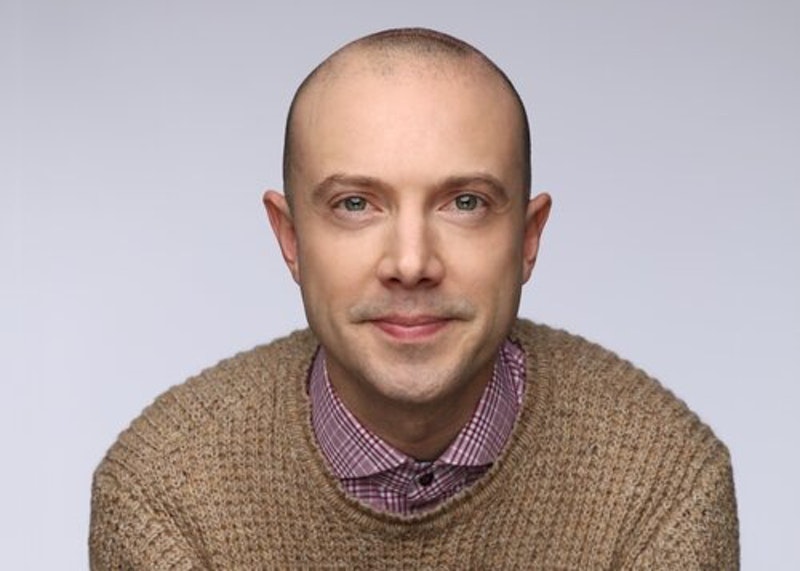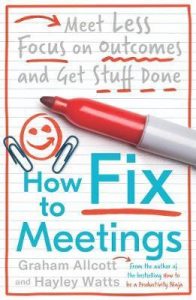Milestone spoke to author and CEO of Think Productive Graham Allcott about the problem with meetings following the release of his new book “How to Fix Meetings: Meet Less, Focus on Outcomes and Get Stuff Done.”
Did you know that the average employee spends nearly 23 full days a year in meetings – over 50% of which are deemed “unproductive” by attendees. Poorly-organised meetings are wasting workers’ valuable time and money – $541 billion globally in 2019.
With realistic and practical advice this book shows how to reduce the amount of time people spend in meetings and ensure that the ones that they do attend or hold are genuine opportunities to collaborate and get things done.
Graham’s new book explains how to ensure a meeting’s focus is on the outcome.
Milestone: What motivated you to co-write the book? Why are meetings broken?
Graham Allcott: My company, Think Productive, has spent well over a decade working with some of the world’s leading companies – from Disney to Amazon to Barclays to the Bill and Melinda Gates Foundation – helping teams with productivity, and in the last few years, the problem of meetings is something that seems to come up more than anything else. Meetings are broken in two seemingly contradictory ways: first, we just need to have fewer meetings. People are overloaded with back to back meetings all day, and are questioning the need for all these meetings. Then the second thing is that we need to make meetings actually GOOD. We need to see meetings for what they really are, which is one of the last spaces that humans have to generously share our attention with each other, and think collectively to solve problems. But the problem with all of this is about a lack of space – if everyone’s in back to back meetings, then there isn’t the space to do the planning needed to make the vital meetings actually worthwhile, and there also isn’t the space to have the perspective to say no to unnecessary meetings, either. There are a few books out there that say “get rid of all meetings” and a lot of books out there that say “here’s how to chair a meeting well,” but what we’ve tried to do in this book is solve it holistically – it’s a book about cutting out meetings, so that we have space for the remaining ones to be great.
M: Is the book only aimed at working professionals?
GA: I always write for working professionals, but I guess there are plenty of other places in life where a good meeting could be planned using these principles – volunteer projects that need to organise teams, family reunions, religious gatherings, local councils… But yes, the main focus of the book is about how to help people free up time and space for deep work and quality thinking, and also make their team meetings or strategy days really count.
M: How much did the pandemic and apps like Zoom play a part in your inspiration to write it?
GA: We were writing it before the pandemic. Our view all the way through is that a lot of the main principles, which are about providing structure to help organise peoples’ thinking, and helping people to orientate towards action rather than just more talk, would be as relevant to working from home and meeting on Zoom as they are to being back in the office. At one point our publisher wanted us to rewrite it as a book about Zoom, which we felt really missed the point. But we actually felt what might be needed when companies are coming back out of the pandemic might be the opposite to Zoom advice – lots of people are having to remember how to do “face to face” meetings well! What happens when everyone’s just in the room together and can’t just turn their cameras off or press mute?!
M: Is it fair to say the book is about making meetings shorter but more productive? Are the methods suggested within based on science/research/your own experiences?
GA: A mixture, to be honest. There’s some science in there around attention spans. Also, we wanted to highlight the research around HiPPO’s. A HiPPO is the “highest paid person’s opinion”: basically, people anchor their own ideas or opinions to be quite closely aligned to the founder or CEO or just highest paid person in the room. And you can counter this by inviting others to speak first, or by asking everyone to write down their votes on paper before they’ve heard from that person, or discussing in pairs. The key with a lot of these things is just having that awareness of the dynamics, and proactively planning to be better. There’s a lot of practical examples too, as both my co-author Hayley Watts and I have been lucky over the years to observe some very skilled facilitators in action, and we also did a lot of research around good practices by people like Jeff Bezos at Amazon. One of my favourites from him is the “two pizza rule” – his principle is that you should always keep meetings small to keep them efficient, and basically if you’ve got more people in the room than you can feed with two large pizzas, you need to invite fewer people. He also makes time at the start of the meeting for silently reading through the papers together – because if you don’t, you end up with a lot of meetings where people are “winging it” but have only skim-read the information. Far better just make the first 20 minutes about making sure everyone is informed enough to be able to make good judgements.
M: Many people I speak to dread meetings, especially on Zoom. What three tips can you give them to improve their experience?
GA: 1. Make sure everyone gets to speak EARLY. The easiest way to do this is via an opening round. Just ask everyone to say their name, how they’re feeling in this moment and one thing that’s going well. This is important as it gets everyone engaged, it allows everyone to mentally “arrive” and put their attention on listening to each other, and it also “breaks the seal” – let’s say someone has something important but contentious to say later, they’re less likely to hold it back if it’s not the first contribution they’re making. If they’ve spoken already, they’ll feel more comfortable saying their piece.
2. The 40-20-40 rule: spend 40% of your time and energy on planning the meeting, 20% on the meeting itself, and then 40% on productive follow-through. Great meetings are all about great preparation and productive meetings are about what happens afterwards, not during.
3. Nothing anyone can say in a meeting is as interesting as a full bladder.
The main focus of the book is about how to help people free up time and space for deep work and quality thinking.
M: How did you become a “productivity professional”?
GA: I was rubbish at productivity in my 20s, and then went through a process of “fixing me.” Once I’d done that, suddenly everyone around me was asking me for coaching and training on how to fix THEM. And that was how I set up Think Productive, my current business. We’ve been doing this work since 2009, with offices in the UK, North America, Australia, and the Netherlands – that’s how I decided to work with my co-author Hayley, too – she’s one of our “productivity ninjas” at Think Productive, and always the one leading our work on meetings with our clients. These days I’m mainly a writer, podcaster, and keynote speaker, but the common thread through everything I do, really, is about helping people to make the space to do meaningful work – and also giving people the sense of security to be able to switch off from it and be fulfilled outside of work too. That still feels like an important and much-needed mission in 2021.
You can buy Graham’s new book here.
Read and download the full article here.








